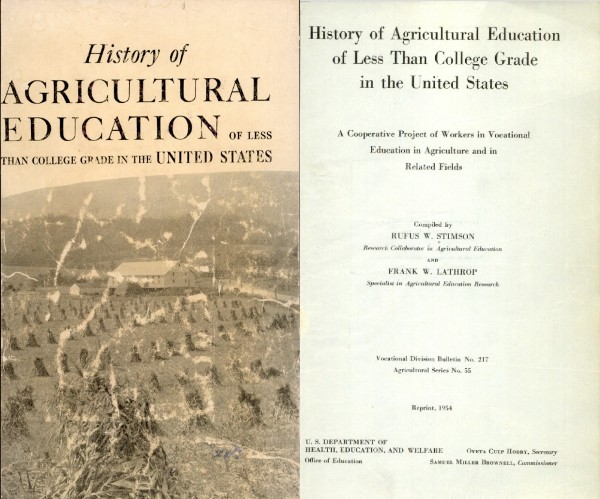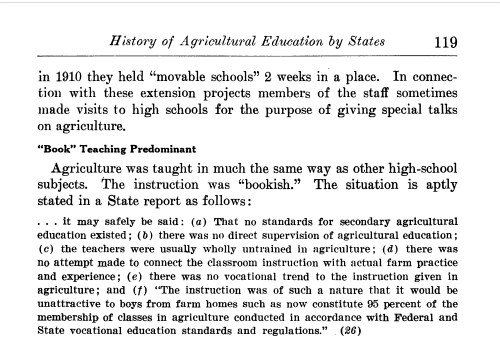Next week the Friday Footnotes will return to focusing on agricultural education programs in the various states. In researching a recent Footnote, “I” is for Idaho, Part 1 I made a discovery that needs to be shared with the profession while it is still on my mind. Graduate students and researchers should pay special attention to this Footnote.
Before I retired from North Carolina State University I taught the introductory research course in the Department of Agricultural and Extension Education. In one of the lessons we emphasized the need to use primary sources for our research instead of secondary sources whenever possible. So what is the difference between primary and secondary sources?
Primary sources are original materials created at or near the time of the event being described. Examples could be original research studies, government documents, conference proceedings, artifacts, personal diaries, and first hand newspaper accounts witnessed by the reporter.
Secondary sources are one or more steps removed from primary sources. Researchers often summarize or interpret information written by others. Typically, secondary sources are written by people who did not have first hand experience of the events or events being described. Thus bias or mistakes can enter into the reporting.
When I do scholarly research to be published in a journal or presented at a conference, I often use a family tree type of approach on sources. If Researcher Joe cites an article written by Researcher Sue, I then go and see what Researcher Sue said and see who she cites. If she cites Researcher Tom, I then go and see what Tom said and who he cited, and so forth. Sometimes the research being cited has gone through 4-5 reiterations and might not accurately be what was in the original primary source. If possible, I go find the original primary source.
Some of us can identify with a party game where one person is whispered a phrase. That person whispers the phrase to the next person in line who then repeats that phrase to the next person in line and so forth until it reaches the end of the line. The last person tells what the phrase he or she was told. It often does not match the original phrase. This somewhat illustrates the problem with repeated use of secondary sources.
A good example of the difference between primary and secondary sources can be seen on television nearly every day. A reporter sitting in a courtroom observing a trial can more accurately report on what happened than a reporter who only interviews a person who was sitting in the courtroom. The same applies to congressional hearings.
When I was teaching the introductory agricultural education research course, I did not have a good example of the mistake one could make by relying too heavily on secondary sources. I needed a concrete example from the Agricultural Education world. I now have that example.
The Bungled Secondary Source
When I wrote the first Idaho Footnote several weeks ago I started by reading about the history of agricultural education in Idaho as reported in the 1942 federal publication History of Agricultural Education of Less Than College Grade in the United States.

Figure 1. Images of the History of Agricultural Education of Less Than College Grade in the United States book.
How did this book come about? When Rufus Stimson retired as state supervisor of Agricultural Education in Massachusetts in 1938 he received an appointment from the U.S. Office of Education to collaborate with Frank Lathrop, a federal agricultural education research specialist to write this book. If you look carefully at the cover page, you will notice that it is stated that this is “A Cooperative Project of Workers in Vocational Education in Agriculture and in Related Fields.”
State education officials and presidents of land-grant colleges were contacted by John Studebaker, the U.S. Commissioner of Education, and asked to participate in this project. Accordingly, each state (plus Hawaii and Puerto Rico) designated a group of people to compile a history of agricultural education in that state. This resulted in 170 state submissions totaling approximately 5,500 typed pages.
Stimson and Lathrop then summarized and synthesized the myriad documents to end up with this 648 page book. It was a herculean task, and it would be next to impossible to publish such a work with no errors.
The Idaho Issue
There are six pages in the history book on agricultural education in Idaho, pages 118-123. There are two primary documents cited for the material in this section of the book. As I read the Idaho section, I thought some information on page 119 was important for the Idaho Footnote. It was a quote from one of the primary sources (No. 26). See Figure 2 below.

Figure 2. Material from page 119 of the History of Agricultural Education of Less Than College Grade in the United States.
The citation for the quoted material was number 26 in the list of references at the back of the book. In the reference section of the history book I found this reference (26) and a second reference (27) listed for Idaho. See Figure 3.

Figure 3. List of Idaho primary sources used in writing the History of Agricultural Education of Less Than College Grade in the United States.
I used the “bookish” quote on page 119 and cited Stimson and Lathrop for that and then included the six statements describing agricultural education in Idaho and attributed that information to Iddings as listed in the references. Then I continued with newspaper articles and other materials for the Footnote.
Later, when I reread the draft version of the Footnote, something struck me as being odd. Why would the Iddings document about the University of Idaho describe the condition of high school agricultural education programs? It was possible but seemed strange. I made the decision to see if I could locate the primary source – the original document #26.
Since the Iddings reference said the document was in the University of Idaho library, I contacted that library. Sara Szobody, the digital archivist in the library located a copy of the report and sent it to me. Here is what she wrote:
This might be the citation the publication included to be by Iddings (26). It has the same title, publication date, and is 12 pages. It’s very possible that the publication you found these references in mistakenly identified Iddings as the author. I’ve attached a PDF scan of this manuscript, so please let me know if you have any trouble viewing.
Sara was correct in stating that Iddings was not the author. The first page of the document contains a transmittal letter written by H. E. Lattig (see Figure 4). It appears that Lattig, not Iddings, is the author. The mistake in identifying Iddings as the author could have been made because Iddings’ name does appear at the top of the stationery. He was Dean of the College of Agriculture
However, a major problem appeared when I read the manuscript. The quotation about the deficiencies in agricultural education programs in Idaho cited by Stimson and Lathrop is not in this document. So where did that information come from? Perhaps it came from Reference 27?

Figure 4. Reference 26 cited by Stimson and Lathrop. (Ctrl +) enlarges.
I then contacted Dr. Kattlyn Wolf in the Department of Agricultural Education, Communication and Leadership at the University of Idaho and asked her if there was a copy of document # 27 in the department. She forwarded my inquiry to Dr. Jim Connors who is now an Associate Dean at South Dakota State University. Dr. Connors did not disappoint. He sent me an electronic copy of the document from his files (See Figure 5).
Guess what? The quoted material on page 119 in the History book was from document 27 – Richardson, Stanley S. (1940). A Brief History of Vocational Education in Agriculture in the Secondary Schools of Idaho. 1917 – 1940 Inclusive. It was not from document 26!

Figure 5. Reference 27 used by Stimson and Lathrop.
By the time I tracked down the two primary sources, the Footnote had already been distributed by email. However, I made the citation corrections on the Idaho Footnote as it appears on the Friday Footnote website which I consider to be the official depository of the Footnotes.
Concluding Remarks
I consider the History of Agricultural Education of Less Than College Grade in the United States to be a good reference but acknowledge it is a secondary source. It is based on a plethora of primary sources, which is good. However, mistakes can be made in the transition from primary to secondary.
While a mix-up in citations in this case is not an earth shattering error, it does make one ask if other mistakes were made in reporting on the history of agricultural education in America. The goal of every researcher should be to be accurate in all aspects of the research, including citations.
A classic example of where an over reliance on secondary sources can be problematic is in the case of the FFA motto – Learning to Do, Doing to Learn, Earning to Live, Living to Serve. For decades the wrong person has been identified as the originator of the FFA motto. See Give Credit Where Credit is Due: The FFA Motto.
The lesson we can learn from this experience is that in conducting research we should, if possible, search out and use primary sources. In the second Idaho Footnote I reported on what was said at seven roundtable meetings across the state. My reporting was based on what Wendy Pratt said. She had personally attended all seven meetings and had first-hand knowledge of the events. She was a primary source.
One concern I have about the current state of research in agricultural education, especially historical research, is that we rely too much on secondary sources. What passes as “research” is merely a summary of what other people have written. We need to dig deeper and find those primary sources.
If you want to examine the two primary Idaho documents, they can be found on a Google drive at North Carolina State University.
#26. Iddings, E. J. Lattig, H. E. History of agricultural education of less than college grade in University of Idaho, 1889-1940.
#27. Richardson, Stanley S. (1940). A Brief History of Vocational Education in Agriculture in the Secondary Schools of Idaho. 1917 – 1940 Inclusive.
